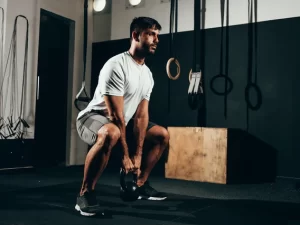It’s a NEW YEAR, so what better time to get started into an exercise routine or improve your current one? Canada’s physical activity guidelines recommend 150 minutes of moderate to high intensity aerobic exercise per week and additionally engaging in strength exercises at least twice per week.

Weight training is so important for every age and some of the benefits include:
- Reduce risk of injury
- Improve pain and reduce inflammation
- Improve metabolic rate (burn more calories throughout the day)
- Regulate insulin
- Improve mental health, sleep, and energy levels.
- Enabling seniors to continue to live independently
So which exercises are the BEST ones to target? We believe they are exercises that mimic fundamental human movements. In other words, FUNCTIONAL daily moves that we do every day! These movements are:
- Sitting down and getting up
- Bending over to pick something up (or someone- ie. children)
- Shutting a heavy door behind you
- Closing the fridge
- Locomotion
So other than opening and closing your fridge door on repeat, how does this translate to an exercise routine? Let us explain.
- Sitting down and getting up = squats. These can be bodyweight squats, goblet squats, split squats, or weighted squats.
- Bending over to pick something up = hinging at the hips. These can be deadlifts, hip thrusts or glute bridges.
- Shutting a heavy door behind you= pulling. These can be seated or bent over rows, chin ups, or pull ups
- Closing the fridge= pushing. These can be pushups on a wall or the floor, bench/chest press with weight, or cable press.
- Locomotion= moving your body from one place to another. This can be as simple as walking, jogging/running, or going up/down the stairs.
Here are some general guidelines when beginning weight training:
- Each strength training session should begin with a brief dynamic warm up.
- Volume: Complete 2-3 sets per exercise to begin. Aim to complete anywhere between 5-12 repetitions. Take 1 minute between sets, or more if needed.
- Control the movement and maintain proper form. Avoid swinging and using momentum.
- Breathe. Exhale as you lift the weight, inhale as you return the weight to the start position. DO NOT hold your breath.
- Progress each week. You can progress by modifying the weight, rest periods, number of sets and reps, and changing your exercises.
- It is normal to feel some soreness for 2-3 days after your workout. This is known as delayed-onset muscle soreness (DOMS). You will learn to love the feeling!
Sometimes it is difficult to know exactly where to start in a strength training program or to know if your current program is appropriate and effective for you. This is where a physiotherapist comes in! Physiotherapists can work 1-on-1 with you to help design a program that is catered specifically to your body and your individual goals. Goals can look different for everyone, and that’s okay! Maybe you want to enhance your performance in your sport, be able to go up the stairs without feeling winded, perform your favourite activity without pain, or just try to keep up with your grandkids !
We hope this article gives you some motivation to get started or to improve your current routine! If you still have questions, don’t hesitate to give us a call @Avenue Physiotherapy🙂
